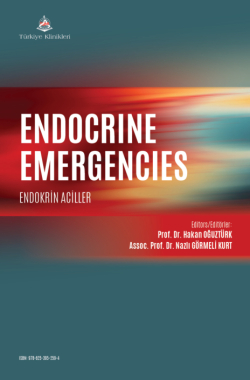Hypokalemia
Gülhan KURTOĞLU ÇELİKa , Sıla EKER KOYUNBAKANa
aAnkara Bilkent City Hospital, Clinic of Emergency Medicine, Ankara, Türkiye
Kurtoğlu Çelik G, Eker Koyunbakan S. Hypokalemia. In: Oğuztürk H, Görmeli Kurt N, eds. Endocrine Emergencies. 1st ed. Ankara: Türkiye Klinikleri; 2024. p.86-9.
ABSTRACT
Hypokalemia is defined as serum potassium levels below 3.5 mEq/L. The primary electrolyte responsible for maintaining the positive charge inside the cell is potassium, and the potassium balance between intra- and extracellular fluids is primarily maintained by the Na+-K+ ATPase pump. The excretion of potassium is primarily regulated by the renin-angiotensin-aldosterone system in the kidneys. Hypokalemia is mostly asymptomatic but it may present with clinical findings such as muscle cramps, muscle weakness and fasciculations, and life-threatening arrhythmias. The main causes of hypokalemia include the use of diuretics, alkalosis, and treatment for diabetic ketoacidosis. Biochemical tests are used in the diagnosis. Replacement therapy can be administered orally or intravenously. Intravenous treatment is recommended for severe hypokalemia, life-threatening symptoms, and arrhythmias.
Keywords: Hypokalemia; electrolytes; potassium
Kaynak Göster
Referanslar
- Tintinalli J.Tintinalli's Emergency Medicine: A Compherensive Study Guide. In: Petrino R., Marino R. Fluids and Electrolytes. 9th Edition. New York: McGraw-Hill Education;2020. p.88-89
- Walls R., Hockberger R., Gausche-Hill M. Rosen's Emergency Medicine. In: Pfennig C., Corey S. Electrolyte Disorders. 9th Edition. Amsterdam, Holland;2019. p.1519-1520
- Comi G, Testa D, Cornelio F, Comola M, Canal N. Potassium depletion myopathy: a clinical and morphological study of six cases. Muscle Nerve. 1985;8(1):17-21. [Crossref] [PubMed]
- Knochel JP. Neuromuscular manifestations of electrolyte disorders. Am J Med. 1982;72(3):521-35. [Crossref] [PubMed]
- Yelamanchi VP, Molnar J, Ranade V, Somberg JC. Influence of electrolyte abnormalities on interlead variability of ventricular repolarization times in 12-lead electrocardiography. Am J Ther. 2001;8(2):117-22. [Crossref] [PubMed]
- Rose BD, Post TW. Hypokalemia. In: Clinical Physiology of Acid-Base and Electrolyte Disorders, 5th ed, Rose BD, Post TW (Eds), McGraw-Hill, New York 2001. p. 863-36.
- Castro D, Sharma S. Hypokalemia. 2023. In: StatPearls [Internet]. Treasure Island (FL): StatPearls Publishing; 2024.
- Kardalas E, Paschou SA, Anagnostis P, Muscogiuri G, Siasos G, Vryonidou A. Hypokalemia: a clinical update. Endocr Connect. 2018;7(4):R135-46. [Crossref] [PubMed] [PMC]
- Clausen T. Hormonal and pharmacological modification of plasma potassium homeostasis. Fundam Clin Pharmacol. 2010;24(5):595-605. [Crossref] [PubMed]
- Brown MJ, Brown DC, Murphy MB. Hypokalemia from beta2-receptor stimulation by circulating epinephrine. N Engl J Med. 1983;309(23):1414-9. [Crossref] [PubMed]
- Mount DB, Zandi-Nejad K. Disorders of potassium balance. In: Brenner BM (ed). Brenner & Rector's The Kidney. Saunders, 11th. edition, Brenner BM (Ed), WB Saunders Co, Philadelphia, 2020. p. 537.
- Adrogué HJ, Madias NE. Changes in plasma potassium concentration during acute acid-base disturbances. Am J Med. 1981;71(3):456-67. [Crossref] [PubMed]
- Bastl CP, Hayslett JP. The cellular action of aldosterone in target epithelia. Kidney Int. 1992;42(2):250-64. [Crossref] [PubMed]
- Goldstein SA. K2P potassium channels, mysterious and paradoxically exciting. Sci Signal. 2011;4(184):pe35. [Crossref] [PubMed] [PMC]
- Ma L, Zhang X, Chen H. TWIK-1 two-pore domain potassium channels change ion selectivity and conduct inward leak sodium currents in hypokalemia. Sci Signal. 2011;4(176):ra37. [Crossref]
- Guo J, Massaeli H, Xu J, Jia Z, Wigle JT, Mesaeli N, Zhang S. Extracellular K+ concentration controls cell surface density of IKr in rabbit hearts and of the HERG channel in human cell lines. J Clin Invest. 2009;119(9):2745-57. [Crossref] [PubMed] [PMC]
- Squires RD, Huth EJ. Experimental potassium depletion in normal human subjects. I. Relation of ionic intakes to the renal conservation of potassium. J Clin Invest. 1959;38(7):1134-48. [Crossref] [PubMed] [PMC]
- Lin SH, Lin YF, Chen DT, Chu P, Hsu CW, Halperin ML. Laboratory tests to determine the cause of hypokalemia and paralysis. Arch Intern Med. 2004;164(14):1561-6. [Crossref] [PubMed]
- Lin SH, Lin YF, Halperin ML. Hypokalaemia and paralysis. QJM. 2001;94(3):133-9. [Crossref] [PubMed]
- Cohn JN, Kowey PR, Whelton PK, Prisant LM. New guidelines for potassium replacement in clinical practice: a contemporary review by the National Council on Potassium in Clinical Practice. Arch Intern Med. 2000;160(16):2429-36. [Crossref] [PubMed]
- Gennari FJ. Hypokalemia. N Engl J Med. 1998;339(7):451-8. [Crossref] [PubMed]
- Kunin AS, Surawicz B, Sims EA. Decrease in serum potassium concentrations and appearance of cardiac arrhythmias during infusion of potassium with glucose in potassium-depleted patients. N Engl J Med. 1962;266:228-33. [Crossref] [PubMed]
- Hamill RJ, Robinson LM, Wexler HR, Moote C. Efficacy and safety of potassium infusion therapy in hypokalemic critically ill patients. Crit Care Med. 1991;19(5):694-9. [Crossref] [PubMed]
- Kruse JA, Carlson RW. Rapid correction of hypokalemia using concentrated intravenous potassium chloride infusions. Arch Intern Med. 1990;150(3):613-7. [Crossref]
- Huang CL, Kuo E. Mechanism of hypokalemia in magnesium deficiency. J Am Soc Nephrol. 2007;18(10):2649-52. [Crossref] [PubMed]
- Whang R, Flink EB, Dyckner T, Wester PO, Aikawa JK, Ryan MP. Magnesium depletion as a cause of refractory potassium repletion. Arch Intern Med. 1985;145(9):1686-9. [Crossref] [PubMed]
- Adrogué HJ, Lederer ED, Suki WN, Eknoyan G. Determinants of plasma potassium levels in diabetic ketoacidosis. Medicine (Baltimore). 1986;65(3):163-72. [Crossref] [PubMed]

